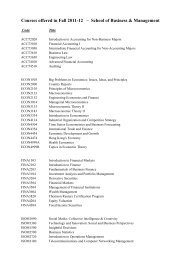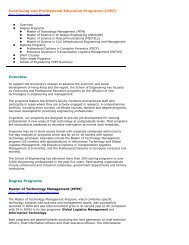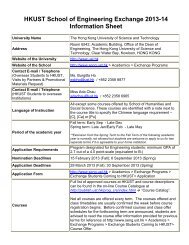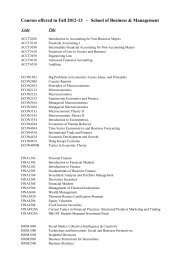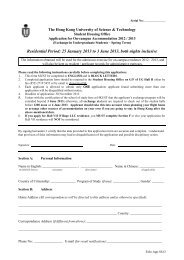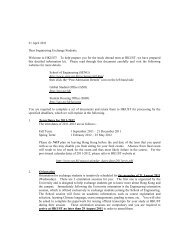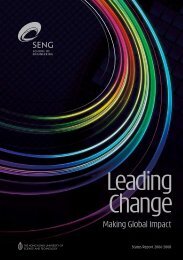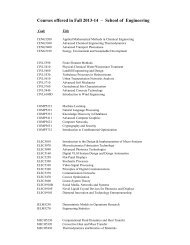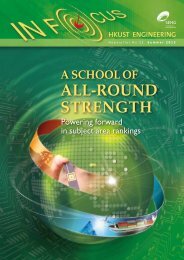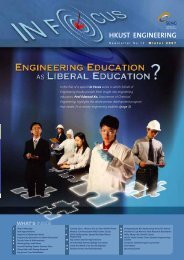pdf version - seng, hkust
pdf version - seng, hkust
pdf version - seng, hkust
You also want an ePaper? Increase the reach of your titles
YUMPU automatically turns print PDFs into web optimized ePapers that Google loves.
Boosting the Use of Carbon Nanotubes<br />
Carbon nanotubes are among the strongest and stiffest fibers currently known. The features of<br />
carbon nanotubes offer opportunities to produce nanocomposites that possess excellent mechanical<br />
properties combined with unique multi-functional characteristics, such as enhanced electrical and<br />
thermal conductivities. However, carbon nanotubes’ potential has been severely limited to date<br />
because of difficulties associated with dispersion of entangled carbon nanotubes during processing<br />
and poor interaction with dispersion media or matrix.<br />
Prof Jang Kyo Kim and his research team have been exploring novel ways to improve battery<br />
performance to a level that next-generation electric vehicles require and to make it possible to realize the<br />
full potential of carbon nanotubes for developing new nano-structured electrode materials. The project<br />
showed significant improvements both in energy and power densities of several different electrode<br />
materials by optimizing the carbon nanotube content and their properties. The research, supported by the<br />
Hong Kong government’s Innovation and Technology Fund and completed in September 2011, generated<br />
10 refereed journal papers in top energy journals and several patents are pending approval.<br />
Microfluidic CTC Device Assists Cancer Diagnostics<br />
Prof Yi Kuen Lee, in collaboration with the David Geffen School of Medicine at the University of California,<br />
Los Angeles, has developed a novel silicon nanostructured Circulation Tumor Cell (CTC) chip with an<br />
integrated micro chaotic mixer for cancer diagnostics. The CTC capture technology is faster and cheaper<br />
than existing methods. The research was selected as the cover story of the world’s leading journal<br />
Angewandte Chemie International Edition (March 21, 2011, doi:10.1002/ anie.201005853) and this<br />
technology was also highlighted in Nature Medicine (March 2011).<br />
Powering Ahead with Clean and Sustainable Energy<br />
Finding the next generation of efficient, clean, energy-con<strong>version</strong> technologies<br />
that operate without the use of fossil fuels is one of the grand challenges of this<br />
century. Prof Tianshou Zhao and his research team are pioneering development<br />
of direct alcohol fuel cells (DAFCs), which can convert the chemical energy of<br />
liquid methanol or ethanol directly into electricity. This type of fuel cell creates the<br />
potential for a cost-effective, energy-con<strong>version</strong> system that is highly efficient and<br />
low in emissions.<br />
Prof Zhao’s recent publications in first-rate energy journals, such as Energy &<br />
Environmental Science and International Journal of Hydrogen Energy, have led to<br />
significant advances in understanding coupled physical and chemical phenomena<br />
in fuel cells, along with many innovations in the design and optimization of nextgeneration<br />
direct alcohol fuel cells with excellent working efficiency. Among other<br />
achievements, his group holds the internationally acknowledged world record for<br />
power density of direct ethanol fuel cells.<br />
Dean’s Message Generating Global Impact Inspiring Future Leaders Tackling the Grand Challenges Cultivating Wider Vision Empowering Excellence Driving the Future<br />
59




